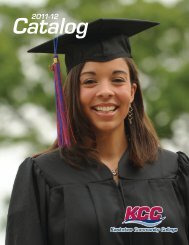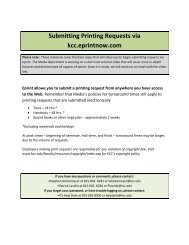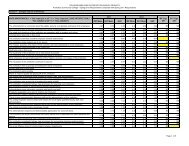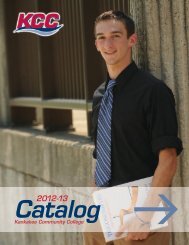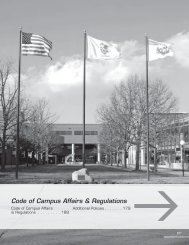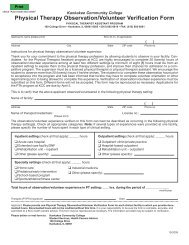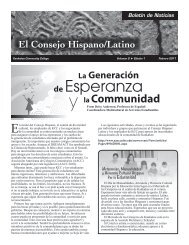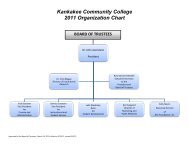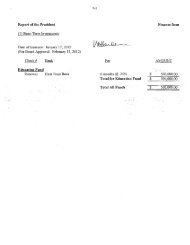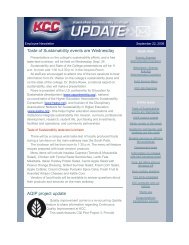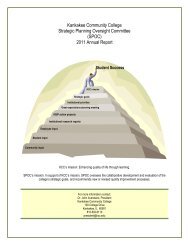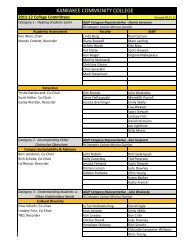09-10_Academiccatalog(Fullcatalog4.30mb) - Kankakee ...
09-10_Academiccatalog(Fullcatalog4.30mb) - Kankakee ...
09-10_Academiccatalog(Fullcatalog4.30mb) - Kankakee ...
You also want an ePaper? Increase the reach of your titles
YUMPU automatically turns print PDFs into web optimized ePapers that Google loves.
the supervision of the program coordinator. A comprehensive<br />
capstone project or legal research project will be required at the<br />
conclusion of the course.<br />
PLAS 2413 - Paralegal Internship 3/0 (3)<br />
Prerequisites: Completion of all required PLAS courses or consent<br />
of the program coordinator. This course is a culmination of all<br />
previous PLAS courses and applies the paralegal skills learned<br />
in class to use in a real-life setting. 240 hours of on-site time will<br />
be required for three credit hours. The program coordinator will<br />
make periodic visits to the site for observation and feedback from<br />
the internship provider.<br />
Paramedic<br />
Students in the Paramedic Supervision and Emergency Medical<br />
Technician programs are advised to consult the Code of<br />
Campus Affairs and Regulations, section 11.4, Page 173.<br />
This regulation concerns completion of all PMED and PEPC<br />
courses in these curriculums with a grade of C or better.<br />
PEPC 1308 - Emergency Medical Technician –<br />
Intermediate I 8/0 (8)<br />
Prerequisite: PMED <strong>10</strong>17; successful completion of the state certification<br />
exam for EMT-B; and proof of current CPR certification<br />
at the “Health Care Provider” level. The student is introduced to<br />
the roles of the EMT-Intermediate/Defibrillator and the paramedic<br />
as well as the ethical and legal aspects of the Emergency Medical<br />
Services system. Human anatomy and physiology are reviewed as<br />
the student studies primary and secondary physical assessment. The<br />
student is introduced to pharmacology and general drug groupings<br />
as well as the calculation of drug dosages using the metric system.<br />
The classification of specific drugs, their therapeutic effect, indications<br />
and contraindications, side effects and correct dosages will<br />
be studied. The student will learn to administer drugs through the<br />
various routes. The student is taught how to use various radios and<br />
telecommunication devices to communicate patient information to<br />
hospitals. The student also will learn how to manage traumatic injuries<br />
including those relating to fluids, shock, and trauma-related<br />
respiratory and cardiac emergencies. Selected clinical experiences<br />
will be provided to correlate with the course content.<br />
PEPC 1318 - Emergency Medical Technician –<br />
Intermediate II 8/0 (8)<br />
Prerequisite: PEPC 1308 or concurrent enrollment. The anatomy<br />
and physiology of the cardiovascular system will be studied, with<br />
emphasis on the structure, function, and electrical conduction<br />
system of the heart as well as the pathophysiology and emergency<br />
management of cardiovascular and non-trauma-related respiratory<br />
problems. The student also will study the electrocardiogram<br />
(EKG) interpretation and treatment of various arrhythmias<br />
and specific treatment techniques including EKG monitoring,<br />
defibrillation, and cardioversion. A variety of common medical<br />
emergencies and their management will be studied, including<br />
those in the areas of obstetric and gynecologic, pediatric-neonatal,<br />
psychiatric, behavioral, neurological, and environmental. The<br />
student also will study infectious and communicable diseases.<br />
PEPC 1324 - Emergency Medical Technician –<br />
Intermediate III 0/8 (4)<br />
Prerequisite: PEPC 1318 or concurrent enrollment. The clinical<br />
rotation requirements for this course are designed to augment<br />
each phase of classroom training. Each student will rotate<br />
through specified patient care areas of the hospital, and will work<br />
under the direct supervision of a registered nurse or physician<br />
to master the practical skills of an EMT-Intermediate while in a<br />
controlled environment. The student will spend clinical time in<br />
the emergency department, obstetrical unit, medical intensive<br />
care unit, surgical intensive care unit, pediatrics department,<br />
psychiatric unit, and the morgue. Each student in this course<br />
must have a physical exam, criminal background check without<br />
any disqualifying convictions and a negative drug screen.<br />
PEPC 1343 - Emergency Medical Technician<br />
– Intermediate IV 0/6 (3)<br />
Prerequisites: PEPC 1318 or concurrent enrollment. This course<br />
is designed to provide the paramedic student with educational<br />
experience in the field of an Advanced Life Support unit. The<br />
student will be required to participate in a minimum number<br />
of ALS calls with a system approved ALS agency. The student<br />
will function under the supervision of an EMT-Paramedic who<br />
has been licensed and active for at least four years and who is in<br />
good standing with the Emergency Medical Services system. The<br />
student is required to complete a minimum number of hours of<br />
field experience on the ALS unit. Students who are not affiliated<br />
with an approved resource hospital EMS system will be required<br />
to obtain a minimum of 50% of their ambulance ride time and<br />
seven of <strong>10</strong> of their ALS calls with an approved resource hospital<br />
ALS agency. Each student in this course must have a physical<br />
exam, criminal background check without any disqualifying<br />
convictions and a negative drug screen.<br />
PMED <strong>10</strong>17 - Emergency Medical Technician –<br />
Basic 6/3 (7)<br />
Prerequisite: Appropriate assessment score; the Office of Admissions<br />
and Registration must have proof of current CPR certification<br />
at the “Healthcare Provider” level; and the student’s official<br />
high school transcript indicating graduation or GED scores<br />
indicating successful completion must be on file. (High school<br />
seniors should consult an adviser for requirements.) To sit for the<br />
Illinois Department of Public Health EMT-B test, the student<br />
must be at least 18 years of age. The course prepares individuals<br />
to provide basic emergency care at the scene of an accident<br />
or illness and to stabilize and transport the victim to a facility<br />
providing emergency medical services. Common injuries and<br />
medical emergencies will be studied along with the roles and<br />
responsibilities of the Emergency Medical Technician—Basic<br />
(EMT-B). Students also will be required to complete a minimum<br />
number of hours of hospital clinical and ambulance ride time.<br />
Upon satisfactory completion of the course, the student will be<br />
eligible to take the state EMT-B test. Each student in this course<br />
must have a physical exam, criminal background check without<br />
any disqualifying convictions and a negative drug screen.<br />
PMED 2408 - Emergency Medical Technician –<br />
Paramedic I 8/0 (8)<br />
Prerequisite: PMED <strong>10</strong>17 and successful completion of the state<br />
certification exam for EMT-B, or a current EMT-B license. The<br />
student will spend a significant portion of this course doing<br />
independent study. The student is introduced to the roles of the<br />
EMT-Paramedic as well as the ethical and legal aspects of the<br />
Emergency Medical Services (EMS) system. Human anatomy<br />
and physiology are reviewed in-depth as the student studies<br />
primary and secondary physical assessment. The student is introduced<br />
to pharmacology and general drug groupings as well<br />
as the calculation of drug dosages using the metric system. The<br />
152 <strong>Kankakee</strong> Community College • 20<strong>09</strong>-<strong>10</strong> catalog




